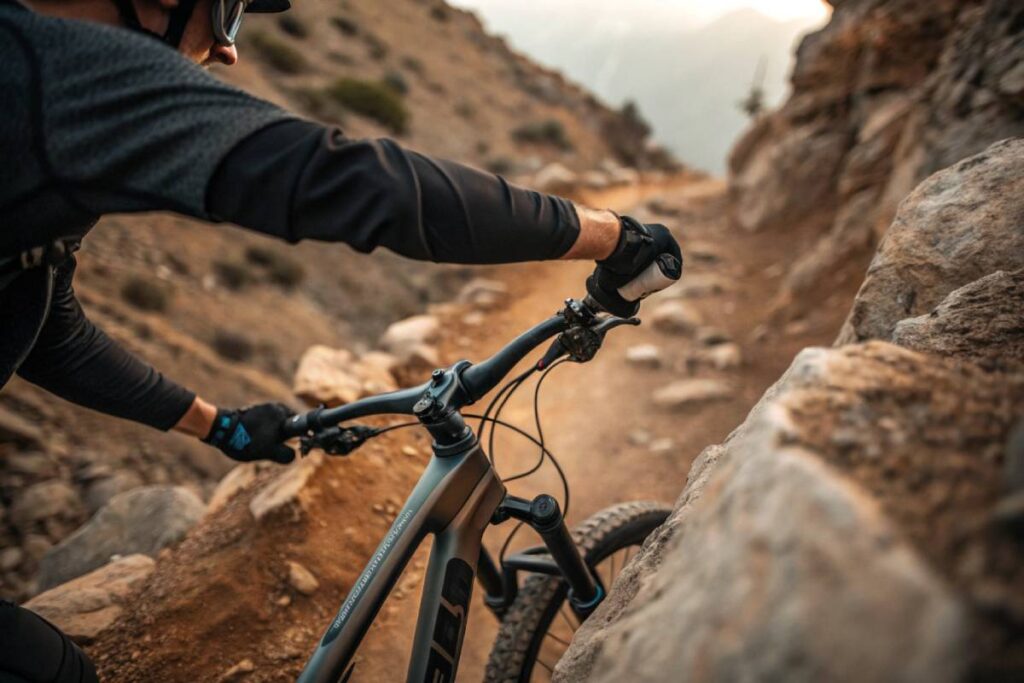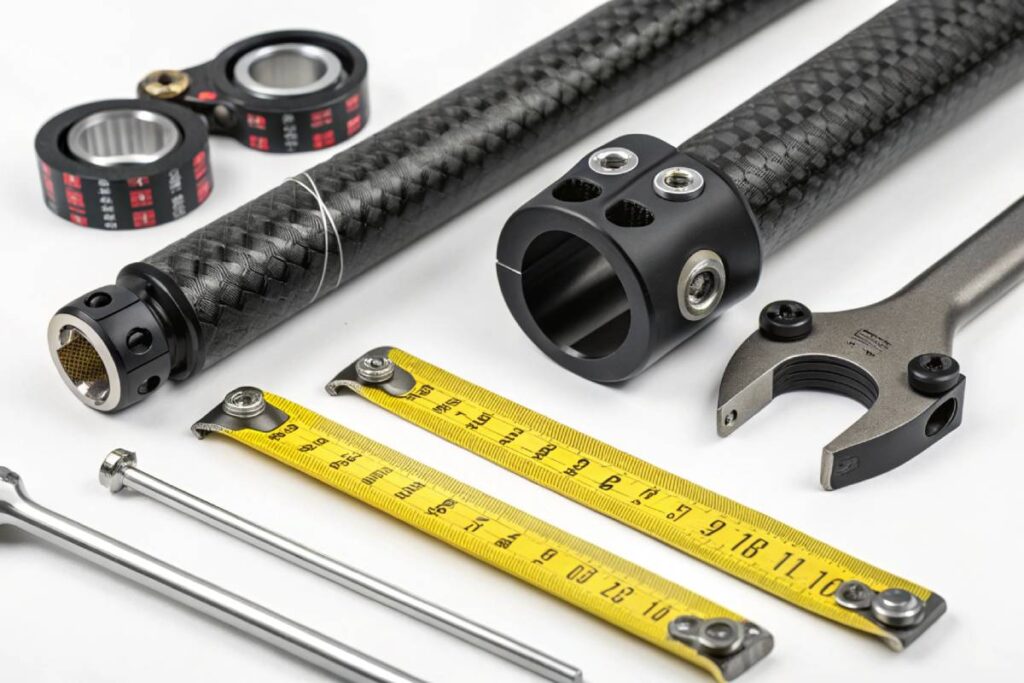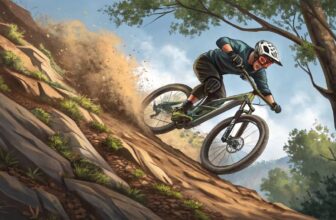Embarking on a mountain biking adventure starts with the right gear, and nothing sets the stage quite like the perfect handlebar width.
Imagine carving through rugged trails with effortless control and unmatched comfort—your handlebars play a pivotal role in making that dream ride a reality.
Whether you’re a seasoned shredder or just hitting the trails, understanding the optimal MTB handlebar width can transform your biking experience from ordinary to extraordinary.
Let’s dive into how finding your ideal handlebar width can elevate every twist, turn, and jump on your mountain bike.
Importance of Handlebar Width
Getting your mountain bike handlebars just right can make biking feel like a dream. Think about it: your comfort and control rely on this. Too wide? You’re struggling to steer. Too narrow? Your ride might feel twitchy. It’s all about finding what works best for you on those trails.

Impact on Riding Experience
The width of your handlebars isn’t just a small detail. It decides how you ride—your posture, how easily you corner or hit jumps. If you’re wrestling with handlebars that don’t fit you well, you’re not enjoying your ride like you should, whether you’re out for fun or competing.
Handlebars that stretch too wide might have you feeling it in your shoulders and could slow down your steering. On the flip side, those too skinny could make you feel every bump, giving you less control. Getting that sweet spot means you’re balancing stability and steering like a pro.

Body Proportions and Bar Width
There’s no magic number for everyone when it comes to handlebar width—your body shape, how you like to ride, and the ground you’re riding on all play a part. Got broad shoulders and you’re tall or heavier? Wider bars might be your thing. Smaller build with narrow shoulders? You might start looking at narrower options.

Check out this rough guide for bar width based on your height:
| Rider Height (ft) | Handlebar Width (mm) |
|---|---|
| Under 5’4″ | 680 – 720 |
| 5’4″ to 5’8″ | 720 – 740 |
| 5’8″ to 6’0″ | 740 – 760 |
| Over 6’0″ | 760 – 800 |
Tall folks might dig the expansiveness of 760mm to 780mm bars, while the vertically challenged could find themselves happier between 720mm and 740mm.
The main idea? Keep those wrists, elbows, and shoulders lined up for better control and less energy drain. Bikers often start larger and clip them down in small bits—like 5mm trims—until it feels just right. Want to dig deeper into making your bike truly yours? Peep our mountain bike sizing guide.
At the end of the day, handlebar width isn’t just a number—it’s a crucial piece of your biking kit puzzle. Whether you’re shopping for your first ride or amping up for more thrills, knowing about handlebar width is your ticket to better biking days.
“The right handlebar width can make or break your ride. It’s all about finding that balance between control and comfort.”
— Jane Smith, Professional MTB Racer
Effects of Handlebar Width
Choosing the right handlebar width will change your biking world. It’s all about how your bike feels, your control over it, and just how comfy it gets when hitting those trails.
Handling and Stability
Your bike’s got a personality, and a lot of it’s in the handlebar width. Go wide, and it’s like a hug from the trail gods—better control, and more confidence, especially when you’re barreling down those steep descents or dancing through tricky tracks. Picture yourself having a solid grip and feeling every twist and turn coming your way.
| Handlebar Width | Stability Rating | Maneuverability Rating |
|---|---|---|
| Narrow (650mm – 700mm) | Medium | High |
| Standard (700mm – 740mm) | High | Medium |
| Wide (740mm – 800mm) | Very High | Low |
The kind of bars you choose can change everything from how you sit and stand to how you corner and jump. It’s like your handlebars have a mind of their own, steering you through all the chaos and calm of the ride.
Terrain-Specific Considerations
Different paths crave different handlebars. Go wide when the going gets tough—think rough terrains, scary steep parts, and places stuffed with rock monsters. A wider grip makes for better control and clearer tracks.
- Rock Gardens and Obstacles: Go big (740mm – 800mm) for stability and over-the-top control.
- Tight Corners and Switchbacks: Slim those bars down (650mm – 700mm) to weave around faster.
- Mixed Trails: Play it safe with a medium width (700mm – 740mm) for a bit of both worlds: steady and zippy.
| Terrain Type | Preferred Handlebar Width |
|---|---|
| Technical Trails | Wide (740mm – 800mm) |
| Narrow Trails | Narrow (650mm – 700mm) |
| Mixed Trails | Standard (700mm – 740mm) |
Want to know more about spicing up your ride? Peek at our tips on mtb cornering techniques.
Impact on Front-End Handling
The width isn’t just for show—it changes how your bike moves upfront. Spread your hands wider on those bars for more chill control at the cost of nimble turns. But keep it tight, and you’re nosing faster through paths, though it might shake you up on the rougher stretches.
Switch up those handlebars, and you might want to rethink how you sit on the bike. For example, if you’re widening those bars, try pulling back the stem by 10mm for every extra 20mm on the handles. Keeps things snug and comfy on your bike throne.
Catch more on fitting your ride to your vibe with our handy guide on mountain bike sizing.
Handlebar width isn’t just a number—it’s the gateway to finding your perfect mountain dance partner. Curious about which bike size matches your inner trailblazer? Have a read of our guide (mountain bike frame sizes).
Finding the Right Width
Picking the right mountain bike (MTB) handlebar size is more important than you’d think – it’s all about riding smooth and comfy. It’s like finding that sweet spot in a hammock: trial and error meets laid-back cruising until everything just fits.
Individual Adjustment Process
Here’s the trick: start big and whittle it down. Grab a wider handlebar and trim it bit by oversized bit till it feels just right. PNW Components reckons you can use the marks on bar ends to snip 5mm at a time. Slowly and surely you’ll find your groove (PNW Components).
| Rider Height | Suggested Handlebar Width (mm) |
|---|---|
| Under 5’6″ | 720 – 740 |
| 5’6″ – 6’0″ | 740 – 780 |
| Over 6’0″ | 780 – 800 |
Trial and Error Method
For those brave enough to tinker — try out new widths in different situations. You’ll get a sharper feel for what helps or hinders your ride. Experts say find that sweet spot where stability, form, and comfort shake hands.
Aligning with Riding Style
Handlebar sizes aren’t just numbers—they’re about how you ride. Are you blasting down gnarly trails or zigzagging up twisty paths? Wider bars give you muscle over bumps and steep drops, perfect for adventurers taking on tough trails (Mountain Bike Action Magazine). But, if you’re a fan of tight twirls and quick spins, something narrower could keep you dancing on the pedals.
Finding that magic number means taking into account the whole shebang: body build, trail conditions, and your ride personality. This is the heart of personalizing mountain biking, making sure every trek is top-notch, whether you’re new to the scene or a seasoned shredder.
Check out more nitty-gritty on stuff like mtb suspension setup and mtb body position in our other pieces to keep your wheels turning smoothly.
Handlebar Width Trends
Mountain bike handlebars have changed a whole lot, haven’t they? Digging into these shifts can help you pick the right handlebar width for whatever kind of ride you’re into.
Evolution in Width Range
If you’ve noticed, mountain bike handlebars are getting wider. This is mostly because the bikes themselves are evolving, too—they’re longer, lower, and have a geometry that suits this kind of handle. Most handlebars you’ll find now are between 700mm and 800mm wide, thanks to this trend.
| Year | Typical Handlebar Width (mm) |
|---|---|
| 2010 | 660 – 700 |
| 2015 | 700 – 760 |
| 2022 | 740 – 800 |
With wider handles, you get better control on those tricky trails when you’re going fast. But don’t stretch them too wide—handling narrow trails becomes a real pain.
Bike-Specific Handlebar Considerations
Picking the right handlebar width isn’t just about following trends. It comes down to body size, how you like to ride, and the terrain you usually tackle:
- Cross-Country (XC): For riders who like a nimble ride and lighter load, narrower bars (720mm-740mm) are a popular choice.
- Downhill (DH) & Freeride: Prefer blasting down hills? Then go for wider options (760mm-800mm) that deliver solid control and keep you steady.
- Trail & Enduro: Gotta be somewhere in the middle? Handlebar widths of 740mm-780mm offer a sweet balance of control and agility (Worldwide Cyclery).
In the big leagues like the EWS and World Cup, pros seem to love the 750mm to 780mm range. This kind of debunks the thought that you need super wide bars to win. Turns out, handlebars around 770-780mm are just right for many, showing you can do great with ones that aren’t the widest.
So, choosing your handlebar width boils down to what works best for you. And if you’re looking to tweak your bike or need upkeep tips, check out our guides on mountain bike maintenance, mtb suspension setup, and how to clean mountain bike.
“Wider handlebars provide the confidence needed for aggressive trails, while narrower ones excel in technical maneuvers.”
— Tom Johnson, MTB Industry Expert
Handlebar Materials and Diameters
Picking the right material and size for your mountain bike handlebars is more than a checklist task—it’s a pivotal part of deckin’ out your bike for the ride you want. Roll up your sleeves; we’re diving into the perks and quirks of carbon fiber versus aluminum handlebars, as well as the ins and outs of clamp diameters.

Carbon Fiber vs. Aluminum
You’re at a crossroads between carbon fiber and aluminum when you’re talking handlebars. Here’s the dirt:
Carbon Fiber:
- Think of carbon fiber handlebars as the Cadillac of handlebars. They soak up those nasty vibrations like a sponge, cutting down on the arm fatigue that sneaks up on long treks. Plus, they’re light as a feather, which doesn’t hurt when every ounce counts.
- Made to flex, not break, these bars glide over rocky trails, making them a treat for long or bumpy rides.
- You wanna shave some weight off your bike? Carbon’s your pal.
Aluminum:
- These bars are built like tanks. They can take a beatin’ and keep on rollin’, perfect for those who ride hard and don’t wanna fuss too much.
- Easier on the wallet, aluminum handlebars hold their ground when it comes to budget-friendliness and availability.
- Strong and straightforward, they transmit a good bit of vibration, giving you a raw, old-school feel of the trail (BikeRadar).
| Material | Vibration Absorption | Durability | Weight Savings | Cost |
|---|---|---|---|---|
| Carbon Fiber | Excellent | Moderate | High | High |
| Aluminum | Decent | High | Moderate | Bargain |
Clamp Diameter Variations
Handlebars hold steady at a 22.22mm diameter where your grips go. But what about where it latches onto the stem? That’s where sizes switch it up.
31.8mm Diameter:
- The old reliable choice that’s been in everyone’s toolbox.
- Bridges stiffness and flexibility nicely, making it solid for a slew of riding styles, from casual cross-country to mad all-mountain antics.
35mm Diameter:
- The new kid on the block gaining props in steep downhill and hardcore enduro scenes.
- Adds a layer of stiffness, giving your steering more oomph without backing down on strength (BikeRadar).
- The flip side? It could pass more trail chatter your way, though some designs out there keep the weight down while still keeping them tough.
| Clamp Diameter | Stiffness | Compliance | Usage |
|---|---|---|---|
| 31.8mm | Moderate | High | All-mountain |
| 35mm | High | Moderate | Downhill, Enduro |
Fleshing out what you need from your handlebars spills into every aspect of your ride, from comfort to performance. To rev things up, peek into our related reads on mountain bike maintenance and mountain bike frame sizes to get all the nitty-gritty details you didn’t know you needed.
Customizing Handlebar Fit
Getting the right handlebar width on your mountain bike isn’t just about comfort; it’s about nailing that sweet spot for control and making sure your ride’s as smooth as a mountain stream. Let’s break down how to tweak your handlebars so they fit like a glove.
Modifications for Optimal Fit
Have you ever tried riding a bike with handlebars that feel off? It’s like wearing shoes a size too small, right? Not fun. Handlebar width needs to match your body and riding style, and there are ways to get it just right. Grab a tape measure and check your hand width while doing a push-up. That’ll give you a ballpark area to start, or, if you like living dangerously, trial and error works too. Here’s a cheat sheet to get you started:
| Rider Size | Bike Type | Suggested Bar Width (mm) |
|---|---|---|
| Small | Cross-Country | 720 – 740 |
| Medium | All-Mountain/Trail | 740 – 760 |
| Large | Enduro/Downhill | 760 – 780 |
Want to dig deeper into sizing your bike? Our mountain bike sizing guide is right up your alley.
Influence on Bike Handling
Let’s talk about how those bars feel once you’re cruising. Go wider for rock-solid stability, especially on dodgy surfaces, but beware of squeezing through narrow trails. On the flip side, narrower bars give ninja-level precision on tricky sections but might make you feel a bit wobbly. The trick? Match the bar width to how and where you ride.
| Handlebar Width (mm) | Stability | Precision |
|---|---|---|
| 720 – 740 | Moderate | High |
| 740 – 760 | High | Moderate |
| 760 – 780 | Very High | Low |
Achieving Balance with Stem Length
Think of the handlebar and stem as best buddies—they work better together. The stem balances your reach and weight, tweaking how the bike feels under you. Here’s a quick rundown for matching stem length with bars:
| Stem Length (mm) | Handlebar Width (mm) | Riding Style |
|---|---|---|
| 30 – 40 | 760 – 780 | Downhill/Enduro |
| 40 – 60 | 740 – 760 | Trail/All-Mountain |
| 60 – 80 | 720 – 740 | Cross-Country |
Hunting for the perfect stem advice? Check out our mtb stem length guide. Remember, the trails and bumps you usually see will guide your choice too, aiming for a comfy ride that’s as controlled as a seasoned pro.
Tweaking your handlebars isn’t just a one-time deal—it’s about finding the right fit for your riding style and terrain. Look into our extra tips on mountain bike maintenance and getting your mtb suspension setup just right. Your bike deserves it!
Rise and Sweep Angles
Understanding Handlebar Rise
Handlebar rise refers to how much taller your handlebars sit compared to their center point. It plays a critical role in how your mountain bike handles and feels as you ride. If you’re adventuring up steep, tricky trails, higher rise bars give you an advantage. They make the bike more forgiving, urging more weight to the back and lending a hand with both comfort and control. Most people choose bars with a rise between 0mm and 40mm.
If you’re aiming for hair-raising descents, it’s usually best to opt for a steeper rise to get the most grip and stability.
| Handlebar Rise | Riding Condition |
|---|---|
| 0mm | Zips along flat paths and speed demons rejoice |
| 10mm | Works for all-around trails, good if you like a mix |
| 20mm | Better for when the paths start to tilt upwards |
| 30mm – 40mm | Tames technical, super steep climbs |
Back Sweep and Up Sweep Importance
Now let’s talk about sweeps—back and up, angles our trusty bars bend back to us and upwards from the stem. Most mountain bike bars have about a 5° up sweep and a back sweep between 7° and 10°. The magic number here tends to be 8° (Worldwide Cyclery). These sweeps can greatly affect how comfy your hands feel and how your upper body positions itself, making your rides smoother and easier on the arms.
| Sweep Angle | Effect |
|---|---|
| Up Sweep (5°) | Lifts your hands, taking pressure off wrists |
| Back Sweep (7° – 10°) | Nudges your hands back, easing shoulder and arm strain |
Effect on Riding Position
Playing with both handlebar rise and sweeps can change the way you sit and move on your bike, impacting both comfort and agility. Higher rise bars lift you upright to handle those gritty climbs while saving energy for the long rides. On the flip side, less rise pushes you forward, perfect for flat-out sprints or when speed is your best friend.
When picking out your perfect handlebar setup, don’t forget to think about mountain bike sizing and MTB body position guidelines. Matching these tweaks with the right mtb suspension setup and mtb stem length guide will make sure you ride smoother than ever. Getting the rise and sweep just right promises comfort, confidence, and control wherever the trail leads.
Expert Recommendations
Pro Insights on Handlebar Width
Got type A handlebars at home that make you feel you’re driving a bus? Well, think again! Pro mountain bikers, those EWS and World Cup champs, share some gold nuggets on finding that sweet spot for handlebar width. It’s a surprise that these top-tier racers aren’t all about going wide. They lean towards handlebars measuring around 770–780mm—definitely not the crazy 800mm span most folks would expect.
If you’re into enduro or downhill bikes, you’ll spot those wider handles, maybe from 730mm to 780mm. Cross-country fans? They usually go for something a bit more snug. While gravity riders might flaunt handlebars over 800mm, it ain’t the norm for the competitive crowd.
A top tip from the pros—experiment! Start with a broader bar, then trim it back gradually. Use the markings on the handlebars and adjust in 5mm bites until you’re in cozy territory. This way, your ride’s comfy, whether you’re built like a twig or have the wingspan of a small plane.
Longevity and Durability Factors
Choosing handlebars isn’t just about size, pal—it’s about what they’re made of as well. There are two key materials in the spotlight: carbon fiber and aluminum. Here’s the lowdown:
- Carbon Fiber: Light as a whisper, strong as steel, and keeps those pesky vibrations in check. But it’s like a fragile egg when banged and needs gentle handling during setup.
- Aluminum: Tough as nails and won’t cry when you beat it up a bit, though a tad heavier. It’s a go-to for many who mean business on the trail.
Weigh up these pros and cons depending on where you’re riding and how extreme you plan to go. Consider how these handlebars work with your suspension setup and stem length, ’cause all these bits together can make or break your ride’s handling.
Want to tweak more? Look under the hood with our guides on mountain bike maintenance and diy mountain bike repairs.
Internal Links Consolidation
For more rock-solid biking insights, check out these topics:
- mountain bike sizing
- mtb tire pressure
- mountain bike maintenance
- mtb gear ratios
- mountain bike brakes comparison
- how to clean mountain bike
- mtb suspension setup
- mountain biking basic skills
- diy mountain bike repairs
- mtb trail ratings
- mountain biking essentials
- how to jump mtb
- mtb chain maintenance
- mountain bike pedal types
- mountain biking safety tips
- best mountain bikes under 1000
- best mtb helmets
- best mtb flat pedal shoes
- best mountain bike lights
- best mtb tool kit
- mtb drivetrain compatibility
- bleed mtb brakes
- tubeless mtb setup
- mtb bottom bracket types
- mtb fork maintenance
- mountain bike frame sizes
- mtb gear indexing
- mtb bearing replacement
- 1x mtb conversion
- how to true mtb wheel
- mtb cornering techniques
- how to manual mtb
- riding rock gardens mtb
- mtb body position
- mtb technical climbing
- mtb braking techniques
- mtb bunny hop tutorial
- mtb line choice
- mtb switchback technique
- mtb drop technique
- 27.5 vs 29er mtb
- mtb grips for hand pain
- mtb rear shock guide
- mtb stem length guide
- mtb tire compounds
- trail riding knee pads
- mtb chain guide types
- clipless vs flats mtb
- mtb upgrade priority
Each link’s like finding a new tool in your garage—keep exploring to perfect your ride!
Conclusion
Choosing the right handlebar width is more than just a technical adjustment—it’s a game-changer for your mountain biking performance and enjoyment.
From enhancing stability and control on steep descents to ensuring comfort on long, winding trails, the perfect handlebar width aligns with your body proportions, riding style, and the terrains you conquer.
By considering factors like rider height, handlebar material, and terrain-specific needs, you can fine-tune your setup for optimal performance.
Remember, it’s all about finding that sweet spot where comfort meets control, allowing you to ride with confidence and ease.
Equip yourself with the right knowledge and accessories, and watch your mountain biking adventures reach new heights.
FAQs
How do I determine the best handlebar width for my mountain bike?
Start by considering your height and shoulder width, then refer to our sizing guide. Trial and error with minor adjustments can help find the perfect fit.
Can changing the handlebar width improve my biking performance?
Yes, the right handlebar width enhances control, stability, and comfort, directly impacting your overall riding performance.
What materials are best for mountain bike handlebars?
Carbon fiber offers lightweight and vibration damping, while aluminum provides durability and affordability. Choose based on your riding style and budget.
How does handlebar width affect bike handling on different terrains?
Wider bars offer better stability on rough terrains and descents, whereas narrower bars provide enhanced maneuverability on tight trails and technical sections.
What accessories should I consider when adjusting my handlebar width?
Essential accessories include quality grips, bar tape or tape wraps, stem adjustments, and vibration dampeners to complement your handlebar setup.




